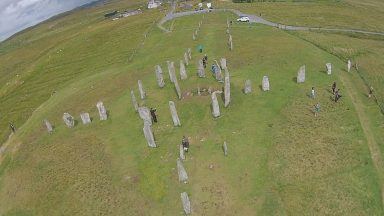The first ever successful tracking of basking sharks has taken place – with a robotic underwater camera.
A ‘SharkCam’ underwater vehicle (AUV) was used in the Hebrides off the west coast last summer to observe and gather footage of basking sharks, the world’s second largest fish after the whale shark.
Little is known about the underwater traits of the globally-endangered species, despite basking sharks being prevalent in Scottish waters.
The research is aimed to reveal new evidence about the marine creatures’ behaviour, and scientists now reckon basking sharks may visit Scotland to breed instead of feed, which has been previously believed.
The SharkCam, one of the world’s ‘most advanced’ pieces of animal tracking technology, followed three basking sharks underwater.
It collected footage of their behaviour from a distance as they swam off the coast of Coll and Tiree, Inner Hebrides.
Analysis of the footage revealed the sharks spending an unexpected amount of time swimming near the seabed – a behaviour which has not often been reported.
Notably the sharks were not seen to be feeding, which researchers believe adds weight to the theory that the species visits Scottish waters not to feed but to breed.
Basking sharks are filter feeders that eat plankton and can grow around eight metres in length.

The Sea of the Hebrides is one of only a few areas worldwide where large numbers of basking sharks are found feeding in the surface waters each year.
The REMUS SharkCam technology was deployed by the Woods Hole Oceanographic Institution (WHOI).
Dr Suzanne Henderson, NatureScot Marine Ecosystems manager, said: “While we weren’t lucky enough to capture courtship or mating behaviour on camera this time, this innovative study has shed more light on the lives of these spectacular giant fish.
“The fact that the sharks spent much more time swimming just above the seabed than we previously thought, and with their mouths closed, is really interesting, particularly as the species is often seen as a pelagic or near-surface filter feeding shark.
“It suggests we may have to rethink not only how many basking sharks are in Scottish waters, but why they are here, as it’s likely not only the plankton they come for.”
Dr Lucy Hawkes, senior lecturer in Physiological Ecology at the University of Exeter, said: “This project gave us a unique opportunity to deploy some of the most advanced animal tracking technology on the planet on these amazing sharks.
“We hope to continue to search for evidence that this may be the elusive breeding spot for the basking shark.”
Dr Lyndsey Dodds, head of Marine Policy at WWF UK, which helped support the AUV study, said: “These missions have given us a wonderful new window into the mysterious underwater world of this huge fish, highlighting previously unseen behaviour, close to the seabed.
“And the more we know about basking sharks, the better we can protect them.”
Amy Kukulya, WHOI research engineer and SharkCam principal investigator, said: “Every time we deploy our tags and SharkCam, not only do we observe something unexpected, but we collect valuable insights that enable us to keep improving this revolutionary technology.
“Longer tracks and a larger sample could uncover why these amazing animals are hugging the seafloor.”
Follow STV News on WhatsApp
Scan the QR code on your mobile device for all the latest news from around the country



























